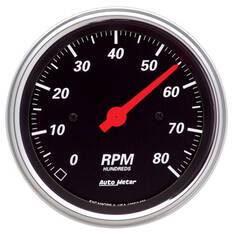The Advantages of Setting Up a Tachometer in Your Lorry
The Advantages of Setting Up a Tachometer in Your Lorry
Blog Article
The Significance of a Tachometer in Checking Engine Rate and Performance in Automotive Applications
In the world of vehicle engineering, the tachometer stands as an essential tool in the driver's arsenal, offering a direct window into the inner functions of an automobile's engine. Past its feature as a plain scale of changes per minute (RPM), the tachometer serves as an essential tool for lovers and experts alike, using real-time understandings into engine performance and health.
Significance of Keeping An Eye On Engine RPM
Checking engine RPM, or changes per min, is an essential element of vehicle maintenance and performance assessment. Engine RPM directly associates with the rate at which the engine's crankshaft turns, suggesting exactly how swiftly the engine is running - tachometer. By keeping an eye on RPM, auto mechanics can evaluate the health of the engine, detect potential concerns, and fine-tune performance. An unusual RPM reading may signify troubles such as engine misfires, malfunctioning trigger plugs, or concerns with the fuel delivery system. Continually high RPM analyses might indicate hostile driving habits or the need for a greater gear change to enhance fuel performance.
Moreover, keeping an eye on engine RPM is crucial for performance examination in racing and high-performance automobiles. In recap, checking engine RPM is not only crucial for spotting problems yet also for optimizing engine performance in numerous automobile applications.

Benefits of Real-Time Data
In vehicle applications, real-time information plays an essential function in supplying instantaneous understandings right into the efficiency and problem of the lorry. By continuously checking various parameters such as engine speed, temperature, fuel consumption, and more, real-time data offers countless benefits that contribute to enhanced performance and safety and security on the roadway.
In addition, real-time data helps with performance optimization by providing instant responses on driving practices and engine performance. Motorists can readjust their habits in real-time based on this information to accomplish better gas economy and lengthen the lifespan of their lorry.

Additionally, real-time data plays a crucial role in contemporary automotive diagnostics, making it possible for technicians to swiftly diagnose and attend to breakdowns. This results in lowered downtime, lower maintenance prices, and inevitably, enhanced total vehicle dependability and long life (tachometer). By taking advantage of the power of real-time information, automotive stakeholders can make educated choices that positively impact both the performance and durability of the automobile
Influence On Gear Shifts
The tachometer plays a vital duty in maximizing equipment changes by supplying real-time engine rate information to this article the vehicle driver. When coming close to the redline on the tachometer, it signifies the vehicle driver to upshift to protect against over-revving the engine and creating prospective damage.
Furthermore, the tachometer help in attaining smoother gear transitions, particularly in hand-operated transmissions. By monitoring engine rate, vehicle drivers can implement equipment changes at the optimum RPM variety, decreasing jerking motions and decreasing endure the transmission components. This accuracy on duty modifications not only boosts driving convenience however likewise contributes to sustain performance.
Enhancing Gas Effectiveness
Given the vital role the tachometer plays in optimizing gear changes for efficiency and engine health and wellness, it directly adds to taking full advantage of fuel performance in vehicle applications. By supplying real-time feedback on engine rate, the tachometer assists drivers in keeping the most reliable RPM range for gas economic climate. When drivers constantly check the tachometer and readjust their motoring practices as necessary, they can prevent unneeded fuel consumption triggered by over-revving or lugging the engine.
Additionally, the tachometer helps vehicle drivers identify one of the most fuel-efficient equipment to be in at any provided minute, protecting against why not try this out the engine from working more challenging than necessary. This is especially crucial during velocity and travelling, where remaining in the best equipment can significantly affect gas efficiency. In addition, the tachometer can alert motorists to possible mechanical issues that might be adversely influencing gas economic climate, such as a sliding clutch or a clogged air filter. In final thought, the tachometer works as a beneficial tool in enhancing fuel effectiveness by promoting optimal driving routines and recognizing locations for improvement in the vehicle's performance.

Making Best Use Of Engine Long Life
The tachometer's role in keeping track of engine speed and performance contributes in ensuring the long life of this contact form automobile engines. By utilizing the tachometer effectively, drivers can maximize engine long life with mindful RPM management. Continually revving an engine as well high can cause extreme wear and tear on critical parts, such as the pistons, shutoffs, and bearings. In time, this can cause lowered engine performance and potential breakdowns. Keeping an eye on the tachometer allows vehicle drivers to remain within the recommended RPM array for their automobile, avoiding unneeded pressure on the engine and extending its lifespan.

Conclusion
Finally, the tachometer plays an important role in keeping an eye on engine speed and performance in automobile applications. By supplying real-time information on RPM, it enables for reliable equipment changes, boosted gas performance, and taken full advantage of engine longevity. This tool is vital for maintaining ideal engine performance and making sure the overall functionality of an automobile.
Report this page